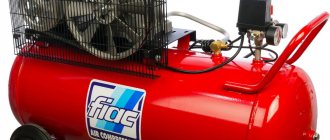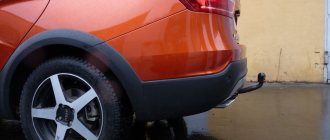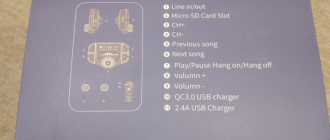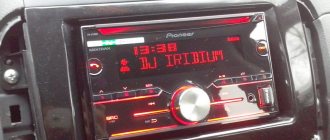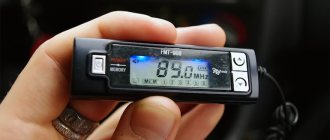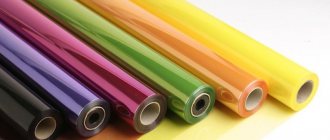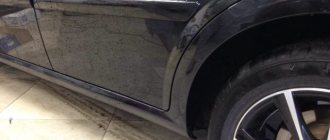When asked which car compressor is best to choose for inflating tires, a car enthusiast is faced with a variety of car compressors on store shelves and display cases. After all, if you list all the “junk” with which you could fill the precious liters of your luggage compartment, then this particular thing claims to be in first place.
Using a car compressor, you can inflate a newly installed spare tire and adjust the pressure in all four tires if there is no tire service or, at worst, a gas station nearby.
We will tell you how to choose a good car compressor, and what characteristics you should pay attention to first of all.
And at the bottom of the page , watch a video review of the best models of electric car compressors for inflating tires.
We also recommend that you familiarize yourself with information about what pressure should be in your car tires, and what consequences can result from too low or high pressure - details at this link.
What else should you pay attention to?
Secondary parameters are also important. Here's how different compressors can differ.
- Connection type - compressors can be connected either directly to the battery (the best option for powerful devices), or through the cigarette lighter to the car network (the best option for most users), in addition, there are compressors with a built-in battery;
- The presence of auto shutdown is a convenient function that will turn off the compressor either when a given pressure is reached, or when the device overheats or the voltage drops in the on-board network of the machine;
- Cable length - it must be at least 2.5 meters so that you are guaranteed to be able to reach the farthest wheel of your car;
- The length of the hose is better if it is about a meter, making it possible to calmly place the compressor on the ground or even in the cabin, rather than forcing you to hold the device in your hands near the nipple;
- Fastening to a nipple - the best option would be a metal fitting, which is more reliable than plastic options;
- The presence of a pressure gauge - without it it is much more difficult to use a compressor, so they are usually built right into the device: a pressure gauge with an analogue scale is more accurate, but a pressure gauge with a digital display is more convenient to use, although it is not so accurate and may not work at all in cold weather;
- The availability of additional capabilities - it all depends on whether you need a compressor for something other than inflating car wheels. And if so, then pay attention to the presence of adapters, a built-in flashlight, the ability to pump out air, etc.
When choosing a compressor, you can rely either on the advice of friends who can suggest specific models or manufacturers, or on reviews of people on trading platforms, where you can compare several devices and choose the best one for you based on price. However, there is one universal piece of advice - if you need a compressor seriously and for a long time, then it is better to give preference to proven brands (Berkut, AVS, AutoProfi, Kachok or even Xiaomi).
Types of pump-compressors for cars
The simplest mechanical compressor is a foot-operated car pump for inflating tires, so to speak, with your own hands. Today you can purchase a model of such a device with almost any characteristics. Single-cylinder and double-cylinder pumps are produced, with a working pressure from 4 to 10 atmospheres, with different capacities, single-stroke and pumping air in two directions of piston movement.
However, a mechanical compressor is inconvenient. Especially if we are talking about inflating the tires of a heavy SUV, or if a fragile girl has to use the unit.
In addition, devices of this class are intended solely for inflating tires and do not offer any additional capabilities. They do not have automatic pressure control, instrument lighting, reverse or change the volume of air supply. Therefore, electric compressor for cars is very popular.
What mistake does the average novice motorist make when he wants to purchase such a useful device for his car? That's right, he doesn't go into the intricacies of the engineering solution and buys the first compressor for passenger cars he comes across. In order not to be disappointed in the purchase, it is worth knowing a little about the basic principles of constructing such devices. Types of automotive compressors differ not only in power supply and performance, but also in the basic characteristics of reliability, maintainability, and operating mode.
Piston compressors
Piston models are the widest segment of products from which it is possible to choose a compressor for a car. The operating principle of such a device is quite simple and similar to the mechanics of an internal combustion engine.
- The electric motor rotates the crankshaft through a gearbox or directly.
- The drive lever located on the shaft moves the piston.
- Moving inside the cylinder, equipped with sealing rings, the piston compresses the air and supplies it with excess external pressure to the outlet pipe.
When operating, an air piston compressor uses two valves. One opens to release air during the main working stroke of the piston. With the help of the second, air is supplied to the cylinder during the reverse movement of the pusher.
Already from the principle diagram of the device, its advantages and disadvantages are visible. The first ones look like this.
- You can choose a compressor for a car with any desired performance. The air supply directly depends on the cylinder volume, engine speed and the number of piston strokes.
- The device can show high efficiency, especially in terms of time use. The two-piston compressor, in particular, supplies air almost continuously, since the two cylinders have a mirror stroke pattern of the pushers. A device with a bidirectional stroke has a similar feature.
- It is not difficult to choose the engine power that will allow you to optimally use the compressor both when connected to a 220V network (directly or through an inverter) and when powered from a cigarette lighter.
The disadvantages of piston models are rarely visible to owners who do not use the device intensively. But they say a lot about overall functionality and limited stability and reliability.
- It is difficult to inflate a car tire with a piston-type compressor in one attempt if we are talking about a large SUV or truck. The device overheats and needs to work only for a certain time, with long breaks to cool down.
- The higher the performance and power of a piston model, the more massive and larger it is.
- O-rings wear out over time, and the compressor ceases to show maximum pressure and performance characteristics.
- The cost of repairing a wheel inflation device when the crankshaft fails can be comparable to purchasing a new model.
- Damage to a cylinder or piston is an absolutely non-repairable case.
- The overall reliability of a piston compressor is considered low, since the design has many moving and rubbing parts. To maintain stable operating parameters, periodic maintenance and replacement of wearing parts is necessary.
The popularity of piston models, despite their ambiguity in the balance of pros and cons, is quite simply explained. This class of compressors is one of the first invented, it is constantly being improved, has been produced for many years, exists in a huge number of models and can offer the ideal balance of cost and functionality for a specific consumer. In addition, piston compressors offer the maximum of existing operating modes and control systems.
Diaphragm compressors
Membrane models are an ideal choice for a female driver; they are quite light, quiet, and productive. This class of devices represents a more modern engineering solution than classic piston designs.
The operating principle of a membrane compressor is simple. Using a cam mechanism, the working rod deforms a rubber plate of complex shape when moving. The air inside the closed cavity to which it adjoins is compressed and supplied under excess pressure to the outlet pipe. When the rod moves in reverse, the outlet valve closes and gas is sucked in through the inlet pipe.
The diagram of a membrane compressor immediately shows its undoubted advantages. Firstly, the device has much fewer moving and wearing parts, the design and kinematics of which are much simpler compared to piston models. Secondly, the main working body - the membrane - can be easily replaced if it is worn out or damaged. Moreover, the cost of such a consumable item is quite low.
The diaphragm pump also has disadvantages. However, they will be invisible to those who use a compressor for car tires or to inflate a rubber boat for fishing. For example, an electric diaphragm pump does not show as high a maximum pressure as piston models that are comparable in cost. Also, the device of this class is characterized by rather modest performance and cannot operate at low temperatures.
However, all the shortcomings of membrane models in the eyes of the average consumer are easily compensated by the enormous reliability of these devices, small weight and size indicators and low noise during operation. A pump-compressor of this class is ideal when powered by a battery; it allows you to pump car tires, can operate continuously and is available both with battery power and 220V power.
Rotary compressor
The last type of compressor that the retail market offers is the rotary. These are models that will be extremely useful for owners of trucks or huge SUVs. The operating principle of a rotary compressor is relatively simple.
- The turbine contains a rotor impeller.
- When rotating, the wheel plates move out of the grooves and are pressed against the surface of the turbine block.
- As you move from the inlet area to the outlet area, the volume limited by the plates decreases.
- The air is compressed and released into the outlet pipe.
Rotary compressors are characterized by the highest performance, significantly exceeding that of piston models.
The difference can be an order of magnitude. If for a piston model the normal figure is 50-60 liters, then the performance of rotary compressors starts from 200-300 liters per minute.
The disadvantages of the rotary model in the form of significant weight, low reliability and low time between failures, as well as the need for periodic maintenance and replacement of wear parts, have led to the fact that compressors of this type have not gained much popularity among average motorists.
Xiaomi 70mai Air Compressor
- inlet flow: 32 l/min
- maximum pressure: 7 atm
- connection type: into the cigarette lighter socket
- voltage: 12 V
The brand, which is associated with mobile electronics, actually produces many types of equipment, including car compressors. The device has a built-in power cable with an adapter for the cigarette lighter, a soft rubber hose, and “needle” attachments. According to the manufacturer, the compressor is capable of operating without interruption for up to 24 hours, delivering up to 7 atm of pressure.
Best Car Compressor for SUVs
Berkut R24
The Berkut R24 SUV car compressor has high performance and is easy to use. Equipped with a high-precision analog pressure gauge. The device is connected to the car battery. It does not vibrate or make noise during operation.
The kit includes: A twisted extension hose on which a DF-029 pressure gauge is installed, 2 adapters for inflating mattresses, 1 adapter for inflating rubber balls with air, a bag-cover for storage and transportation.
Pros:
- High efficiency.
- Accurate analog gauge readings.
- Low noise level.
- Inflating tires takes little time.
- The collet connection of the air hose and the deflator valve do not increase the temperature during use.
- The connection to the wheel does not get very hot during long-term operation, the temperature is comfortable for the hands.
- The air flow rate is 64 liters per minute, which is more than most compressors of this type.
- High-quality assembly and components.
- The kit includes replacement nozzles.
- Light weight - only 5.5 kg.
- Small dimensions: 350x140x183 mm.
- Long operating time without interruption - 1 hour.
Minuses:
- The switch button cap is too hard.
- When the compressor operates for a long time, the cylinder head becomes very hot.
Berkut R15
- inlet flow: 40 l/min
- maximum pressure: 10 atm
- connection type: into the cigarette lighter socket, to the battery terminals
- voltage: 12 V
A much more serious device that has parameters suitable for the average motorist. There are also possibilities for connecting not only to the cigarette lighter, but also directly to the battery, and built-in overheating protection, and a set of adapters for working not only with car tires.
The best car airbrush compressor
Fiac Cosmos 50
The FIAC SUPER COSMOS 50 piston oil compressor is used in everyday work and repair shops for working with airbrushes.
Has great power and performance. The weight of the device is high, but this is compensated by the presence of wheels for transportation. The device operates from a 220 V household network.
Pros:
- Excellent productivity - 240 liters per minute.
- Large receiver volume – 50 liters.
- Low level of noise and vibration produced during operation.
- The highest working pressure is 8 bar.
- Has a support leg for stability.
- Two high-precision analog pressure gauges.
- Pressure regulation reducer.
- Wheels for transportation.
Minuses:
- Takes up quite a lot of space. Dimensions: 760 x 320 x 670 mm.
- Heavy weight: 36 kg.
- High price.
"Jock K90"
- inlet flow: 40 l/min
- maximum pressure: 10 atm
- connection type: into the cigarette lighter socket
- voltage: 12 V
Its characteristics are similar to the Berkut model, but it does not have the ability to connect to the battery directly, but otherwise it can give its owner almost the same functionality, having both overheating protection and complete adapters in the kit.
All of the listed car compressors have good ratings and ratings from users, so you can confidently use them for inflating wheels and some small things. But if you have specific requirements for compressors, then you will have to study the market in more detail to choose the device that suits you.
Here are a couple more useful articles for every driver:
- The best DVRs: what to choose from different brands?
- Which radar detector to choose for the city and travel?
The best car compressor with battery
AIRMAN OWL 2000
The battery-powered compressor is designed specifically for those who don’t want to bother with wires. And although the AIRMAN OWL 2000 is not the highest performance device, it is the best example among battery-powered compressors.
Recommended for inflating tires of small passenger cars.
Pros:
- No need to fiddle with wires.
- If desired, the device can be connected to the cigarette lighter socket, while the performance of the device and the air supply speed are significantly increased.
- Small dimensions: 205x75x60 mm.
- Light weight: 1 kg.
- Long power cord – 3.4 m.
- Low current consumption. Maximum consumption – 14A.
- Excellent equipment: replaceable battery with a power of 9.6 V; a set of interchangeable nozzles of different sizes; Charger; wire for connecting the device to the car cigarette lighter socket; convenient bag for transportation; automatic pressure regulator.
Minuses:
- Low productivity - 18 liters per minute.
- Slow pumping.
Wheel inflation rules
If you have a compressor, but no experience in inflating wheels, then you should conduct exercises. To do this, it is enough to know the rules that will help you act in a certain sequence:
- take the compressor and free it from the protective cover;
- install next to the flat tire;
- unscrew the nipple cap and place the hose tip on the fitting;
- take the plug and connect it to the cigarette lighter;
- we return to the wheel and turn on the toggle switch on the compressor;
- after pumping up the required pressure, turn off the toggle switch;
- remove the compressor in reverse order.
The pump hose tip has a lock. In the vertical position, the valve is closed and the tip is ready to be attached to the wheel fitting. After moving the lever to a horizontal position, the tip is fixed on the fitting, opening the nipple for air supply.
The best two-piston foot pumps for cars
Elegant Maxi 100 335
The budget model is designed for inflating tires of small cars, bicycles, mopeds, etc. The Elegant Maxi 100 335 pump is installed on a frame with rubberized legs. The pedal is equipped with a special anti-slip pad. Thanks to two cylinders, pumping is much faster compared to single-cylinder analogues. The portable design takes up little space when folded and fits perfectly into the trunk. The pump provides an output pressure of 7 atmospheres. The built-in pressure gauge is used to regularly monitor tire pressure.
Pros:
- Ease of use.
- Compact sizes.
- Light weight.
- Quick tire inflation thanks to two cylinders.
- Warranty – one year.
Minuses:
- The pressure gauge does not always give accurate readings.
Ring Automotive RFP2
The Ring Automotive RFP2 double piston foot pump is manufactured in the UK. In the manufacture of this model, high-quality wear-resistant materials are used. The body parts are made of durable steel. The delivery set includes additional nozzles for inflating bicycle, motorcycle tires and other inflatable products.
Pros:
- Light weight – 1.8 kg.
- Practical design.
- Long service life.
- Ease of use, storage, transportation.
- Safety (anti-slip pads).
- Foldable design.
- Stable thanks to rubber coated feet.
Minuses:
- The connecting hose is inelastic.
Alca 225,000
The Alca 225 000 double-cylinder foot pump is used to inflate not only car tires. The model is also adapted for bicycles, air mattresses, rubber boats, and children's soccer balls. Thanks to its high-quality design, the 225 000 pump has improved performance characteristics. The overall dimensions of each cylinder are 300x145x90 mm. The design provides a built-in pressure sensor - manometer.
Pros:
- Small dimensions.
- Light weight.
- Reliability, durability.
- Versatility.
- Mobility.
- In one cycle, the device is capable of pumping a large volume of air.
- Safety, ease of use (the foot does not slip off the rubberized pedal).
- Minimal physical activity (tires are inflated using the driver’s weight).
Minuses:
- High price.
Which compressor is better: foot or electric?
Currently, there are two main types of compressors on sale: an electric device powered by a cigarette lighter and a traditional foot-operated compressor for inflating tires. Note that the first option is more convenient and even a novice car enthusiast or a female driver can cope with inflating the wheels.
In order to ensure the acceptable quality of the product and its reliability, first of all pay attention to its design features, data on which can be found in the technical documentation of the compressor. The material from which the cylinder of the device is made must be of high quality; as a rule, it can be: alloy steel, stainless steel, or, in extreme cases, an aluminum alloy. Also of great importance is the compressor piston and how it is installed, the most optimal option for placing the connecting rod directly on the shaft itself. Happy shopping!
The best automotive stationary compressor
Berkut PRO-24
The stationary vehicle tire inflator Berkut PRO-24 is one of the most powerful. It has high performance and compact dimensions.
The main distinguishing feature of the device is its long continuous operation. The device is equipped with an overheating sensor and an IP67 protection system. The kit includes an installation kit.
Pros:
- High productivity - 47 liters per minute.
- Possibility of continuous operation – 2 hours.
- Protection against temperature changes.
- Water protection – I
- Installation kit.
- High efficiency.
- The operating power of the device is 250 Watt.
- Not very high noise level.
- Small dimensions – 284x102x167 mm.
- Light weight, for stationary installation - 5.6 kg.
- Temperature range at which use is possible: from -30 °C to +80 °C.
Minuses:
- Short hose – 50 cm.
- High current consumption - 21 A.
